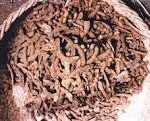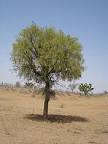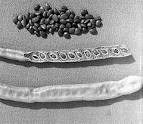Prosopis cineraria
Uses
India (Rajasthan): the bark of this tree was eaten during the severe famines of1899 and 1939. The bark was stripped off, dried, and ground with any available coarse grain. (Shankar reports the bark was boiled). Bread is reported made from the ground bark, with or without the addition of other flour. Dried seeds and leaves also ground and mixed with flour for making bread. The bark has an astringent, bitter taste and is reported to cause grippeing. (Rajasthan, western ): unripe pods used as vegetable, being boiled and stored for lean periods. Fresh unripe pods also used as vegetable. Light brown to deep brown ripe pods eaten raw. In the Marwar region, the dried pods are eaten raw as well as boiled and dried to make Panchkut – a mixture of five fruits and seeds (e.g. Acacia senegal, Capparis decidua, Cordia myxa, Cucumis melo and Prosopis cineraria) which are harvested semi-ripe, boiled and dried. The flowers and buds are reported eaten mixed with curd. Madahya Pradesh: the Gond and Saharyia tribes eat the pods and bark.
Additional Information
- Name Authority:
- (L.) Druce
- Vernaculars:
- Rajasthan (Jaisalmer district) (whole plant): Khejra. Rajasthan (western): Jant, Khejri. (Ripe pods): Khaka, Khokha, Sangri. Madhya Pradesh (Hindi dialect): Shami, Kshenkur.
- Misc:
- Soil types favored by plant: sandy plains, sand dunes, and interdunal areas. Chemical composition: see Jain & Tiwari




